This was not something we thought to include, but the indigenous birdlife is vanishing so rapidly, that unless we do, some may not be well recorded at all. We see that the best Net site available, “New Zealand Birds” uses only copies of paintings!!! On average, the numbers of sea-birds found on our coasts number now about 10% of what they did 60 years ago, in some cases, eg paradise ducks, even less.
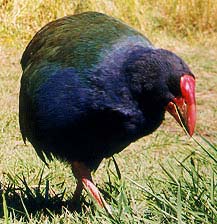
A few million years of isolation in a land of moderate climate, in the complete absence of predators, did not leave the indigenous inhabitants with many ideas of defense. Shore, sea and migratory birds remained active, the insect-eating and honey sucking varieties kept their flight ability, but nested in vulnerable places while the swamp dwellers and feeders on grass seed mainly lost the ability to fly. The presence of fifty million sheep means that very little grass seed is ever to be found
Not only the giant Moas (larger than the ostrich) but several species of the smaller variety, the flightless goose, flightless rails, the ground snipe could exist on the ground only. Even the bright blue long-legged Pukeko swamp rail can fly in a heavy fashion for a short distance but does not bother unless chased. The Kakapo, a ground acrylic color parrot, was similarly defenceless, and of the two related parrots, the red Kaka is vanishing fast, and only the dark green mountain parrot, the Kea, nesting up in the rocks and fogs where stalking cats do not care to go survives well. Keas fly down to amuse themselves harassing tourists cars and camps. A Kea can pick a tent, or camera case or soft topped car to pieces in half an hour. There is another large flightless bird called the Takahe related to the Pukeko. But I have never seen one. The kindly and friendly grey duck has been hybridized by the imported Mallard and pure stock have ceased to exist. The Blue Mountain Duck was always rare.
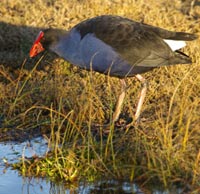
On the river flats the Pied Oystercatcher and Black Oystercatcher roamed about in flocks with their “Pip-squeak” call but are now rarely seen, their place being taken by the spur-winged plover which arrived recently from Australia. Nesting sites on gravel river beds are trampled by herds of cattle and sheep. The related black and white “Stilt”, a wader with long delicate red legs that it lifts entirely out of the water as it wades the edges of swamps seems to be much reduced in numbers, the thousands of swamps which once existed now being almost all drained.
Shore-feeding Blue Herons are still seen, the larger graceful White Heron nests mainly at Okarito Lagoon on the West Coast, but the destruction of the podocarp forest behind has allowed severe flooding; as seen from the air, mud flows miles out to sea through the lagoon and the White Heron is now rarer than ever. We are reputed to also have Spoonbills, also from Australia but I have never seen one. Ground-nesting Dotterels and Skylarks had no chance at all, though not yet extinct.
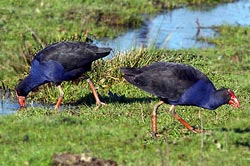
The arrival of the Polynesians spelled disaster as NZ has little in the way of food resources for primitive people. There are large eels in rivers, in the 1930’s a bleeding rabbit thrown in the Clutha could attract twenty eels within minutes, but they are no longer seen nor are the small native trout, the fry of which are probably eaten by the imported Rainbow, Brown trout and Quinnat Salmon. Colonies of seals along the coast which were soon exterminated in the more accessible places but are showing signs of returning in spite of the allowable and not enforced “limit” of 80 seals killed a year as “By-Catch” by trawlers.
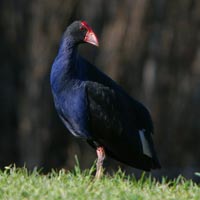
The varieties of Moa, swan and geese were hunted in pre-European days by setting lines of fire and driving into groups of men with club and spear. It is argued they may have existed until about the late 18th century but the Maori had forgotten they existed by the early 19th century. Neither the coconut nor the breadfruit will grow here, and the Peruvian sweet potatoes (kumara) only in the frostless north. The main diet became pounded fern root, which is hard on teeth, together with pipis, tuatuas, cockles (shell-fish) and fish caught either in primitive nets or crude wood and bone hooks. A decent meal could only be had by raiding the tribe next door or consigning a slave to the cooking pot! There is no edible fruit, the drupes of a tree called the Karaka contain prussic acid but if this is leached they can be eaten. One wonders how many died to find this out!

The flightless Kiwi (which I’ve been told tastes like “old socks”) was decimated, surviving only in zoos, but a few of its more active cousin, the flightless Weka or “Maori hen” survived.
The song birds, the Tui, the Bellbird, the Waxeye, the Fantail, the Bush Wren, the Grey Warbler, the Shining Cuckoo and Long-tailed Cuckoo largely met their end at the hands of the Europeans pet cats, and liberated stoats, weasels, polecats, liberated in the vain hope they might control the disastrous spread of the introduced rabbit, as well as ships rats who jumped ships. All found feathers easier to catch than a swift bunny.
Bellbirds look like a slim blackbird and toll a bell like note. The greenish Tui has a tuft of white feathers at the throat and was often called “The Parson Bird” or the “Mocky” due to its habit of imitating other birds, or even a shepherd whistling his dog, to perfection. It seems to have lives mainly on flax nectar but the huge flax swamps are now all gone. While not yet supposed to be extinct the tui has become “rare and endangered”
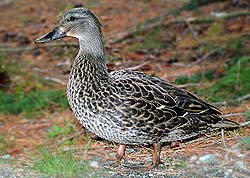
Fifty years ago when camping in the bush, as the sun rose, the forest trilled to the “dawn chorus” of thousands of birds, greeting the new day. It is no longer to be heard. Once to see the active Fantail darting about after insects, it was only necessary to go into the garden. Not any more!
Donald Hay in about 1837 reached the shores of Lake Wakatipu, the mountainsides being covered in centuries of growth of bracken fern, the flats by spiked matagouri. Accidentally (he said) a match was dropped into the fern, and the fires swept the hillsides for days. He and his companion and horses had to shelter neck deep in the lake. He speaks of thousands of “fern-birds”, feathers scorched, fluttering helplessly into the lake. The hills have been burnt every year for a century and a half to clear the fern for sheep, now we are not sure what the “fern-bird” might have been. A whole ecology has been destroyed, not an acre of fern-covered hill was preserved.
South-west of Dunedin 50 years ago the hills between Maungatua and Rock and Pillar were covered in waist-high red tussock. Now all is gone, plowed under, or sprayed and aerially resown, another whole ecology has vanished. There are no reserves except for a small area down near “The Key”, which is grazed by cattle. On the eastern side of the alps were about 64,000 sq miles of silver tussock and snow tussock, now largely gone or severely battered by a hundred and fifty years of burning, over-grazing and rabbit plagues. There are no reserves, a small area at Lindis Pass declared a “reserve” is both grazed and has briar spreading slowly into it. I do not think that anything is known as to what the ecology of the grasslands (once the moas had been exterminated) might have been, In mountain valleys the blue male paradise duck and his white-headed mistress with reddish wing tips are still occasionally seen, but not in the flocks they once were. They nested on the flats in flax clumps now destroyed by cattle as all the lower river flats are now grazed. Once, if you approached their nests or goslings they would dive threateningly, or run in front dragging a “helpless”, “broken” wing to lead you away. Now how did they learn that trick? It would be most effective against dogs, possibly some maori dogs ran wild.
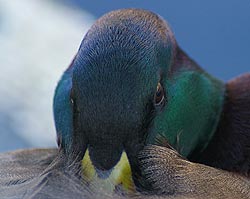
The large and attractive native pigeon is a slow flier and could be caught in nooses on a long pole. We saw one in the remote Cascade Valley in South Westland only a year ago. The smaller imported pigeon has fared much better, it has the wit to nest in cliff-faces and under bridges in the middle of rivers where cats and mustellids cannot go. Similarly European birds nest in the extreme tree tops or on the ends of branches too light to support a cat.
In the north from Farewell Spit to Parengarenga the migratory Turnstones, Wrybills, Godwits, Sandpipers and Curlews gather in flocks before migrating to Siberia. They are still caught in nets between poles as “traditional food” by the natives and now are mainly to be seen only in the far northern tidal harbours.
One of the few birds that seems to be thriving is the Harrier Hawk which may have a wing span of about 3 – 4ft. It lives on carrion and the roads provide plenty of dead rabbit and possum. Its smaller and more active cousin, the sparrow hawk is a hunter and as the flocks of native birds have gone so has the sparrow hawk. The harrier nests high in the rocks and with its shrilling cry and brilliant piercing eyes it would be a brave mustellid that would attack one.
The night owls whose “whoops” used to frighten us as children with their eerie sound seem to have gone completely, even the imported German owl and the once common Morepork; at least I have not seen either for many years.
With cropping, European birds were brought to control insects, including the common blackbird, thrush, sparrow, goldfinch, greenfinch, yellowhammer, magpies, and others and were to be seen in huge flocks. Then the NZ government decided to import cheaper wheat from Argentina, and cropping largely died and so did most of the birds which lived on the grain.
Some History
On the lower Otago Harbour there has been for several hundred years, a native village or kainga, (a “Kaika” in Southern dialect), known to this day as “The Kaik”, the current occupants being called the Kai Tahu. In the early 19th Century, they came down from the Wairarapa area of the North Island and exterminated or enslaved the previous occupants of the whole South Island, who were called the Ngati Mamoe. However, they deserved little sympathy as THEY had also come down earlier and exterminated and enslaved the Waitaha people. Whether the Waitaha were in fact the “Moa Hunters” or whether they had killed off an even earlier unknown people sometimes called the Moriori who hunted moas, is not known.
In about 1827 an even bloodier minded old savage called Te Rauparaha armed his men plus some conscripted Atiawa with muskets, eliminated about 10,000 Kai Tahu at Kaikoura, and another large number at Kaiapoi near Christchurch while Te Puoho, a relative, ravaged the West coast and descended on Southland where he met his end at the hands of a local group headed by one “Bloody Jack” Tahuwaiki, who lived on Ruapuke Id, but had some associations with “The Kaik”. The crew of a whaler who landed near the Otago Harbour entrance in an earlier era were immediately attacked by the locals but the whalers defended themselves stoutly with their flensing knives and got rather the better of the encounter. For two centuries the bay was known as “Murdering Bay” but now has been given a more politically correct name, probably “Welcome Bay!”
Then came Governor Grey, who said “Tut! Tut!” and put Te Rauparaha under house arrest for many years. Trendy historians to this day refer to Grey’s “illegal detention of Te Rauparaha”.
In other words, the local history is sanguine in the extreme and food was always scarce. An omelette of shags eggs would no doubt have been highly acceptable over centuries, so how did they escape? There may well have been an old albatross colony at Taiaroa, but albatross nests are too easily raided. Did the shags just happen to nest on those so convenient cliffs where they could dry their wings, and look down into the deep kelp beds swirling back and forth, or did they awake to a new danger and say “Let us move to an inaccessable place?”
As we can, we will add some pix of what remain. When one considers that the entire South Island east of Alps has had virtually all forest, scrub, bracken fern and much of the tussock grassland destroyed and been fenced, grassed and grazed, it is positively amazing there is a single native bird left. In Otago Harbour some have found narrow strips between tide and roaring traffic.
It is rumoured that Oysterctachers now nest in cypress trees planted as shelter belts. As there are almost no reserves, it is not likely that many will survive the next half century. The horrendous losses to the long-lining industry, (300,000 albatrosses and shearwaters in the Tasman – Southern Ocean area per year) mean that more than half of all albatrosses are on the “Critically Endangered” list. It has been claimed that 13 million hooks may be set in a day to catch tuna. Hopefully, when the tuna become extinct the tuna boats will go home, but in some areas they are switching back to sword-fish. The habit the fishing industry has of “fishing to extinction” means that most albatrosses especially must inevitably disappear. What an insane world we live in!
